We originally bought several of the MikroTik S+RJ10 modules when they first came out, and were, well disappointed. Although the MikroTik S+RJ10 carries the same model number, there is an enormous delta between the first and second revision parts. In our review, we are going to discuss the newer rev 2.16 version.
MikroTik S+RJ10 Overview
The MikroTik S+RJ10 is a relatively simple to understand device. One end plugs into a standard SFP+ port on a switch, and the other has a RJ45 port. Essentially, the S+RJ10 converts a SFP+ port into a standard copper networking port.
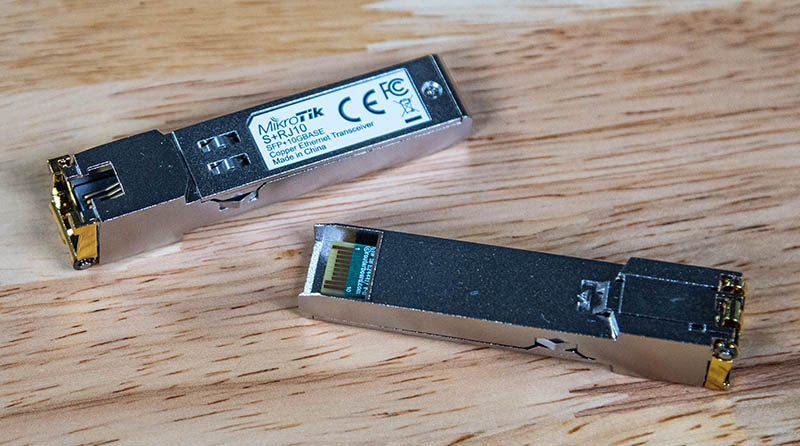
It goes a bit beyond a standard RJ45 in this case. These types of adapters have been available for years going from a 10GbE SFP+ port to a 1GbE RJ45 port. Even only 3 years ago major vendors were selling SFP+ to 10Gbase-T adapters for thousands of dollars. Power consumption and heat are so much higher with 10GbaseT, and the SFP+ module is so compact, that that was a major concern. Now, using the Marvell 88X3310P, we have solutions like the S+RJ10 that can run at only 2.4W on a 30m 10Gbase-T link and therefore fit in many switches.
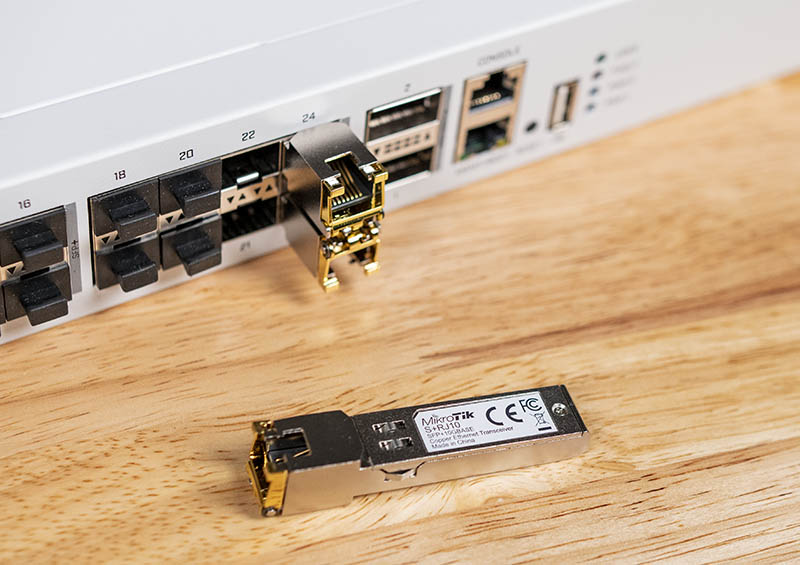
Beyond enabling the ecosystem, there are other benefits. First cost. MSRP on these modules is $65, but street price is $55 +/- $4. If you have a 10Gbase-T device, such as a server, or NAS, this relatively low cost makes it economical to add 10Gbase-T to a SFP+ switch.
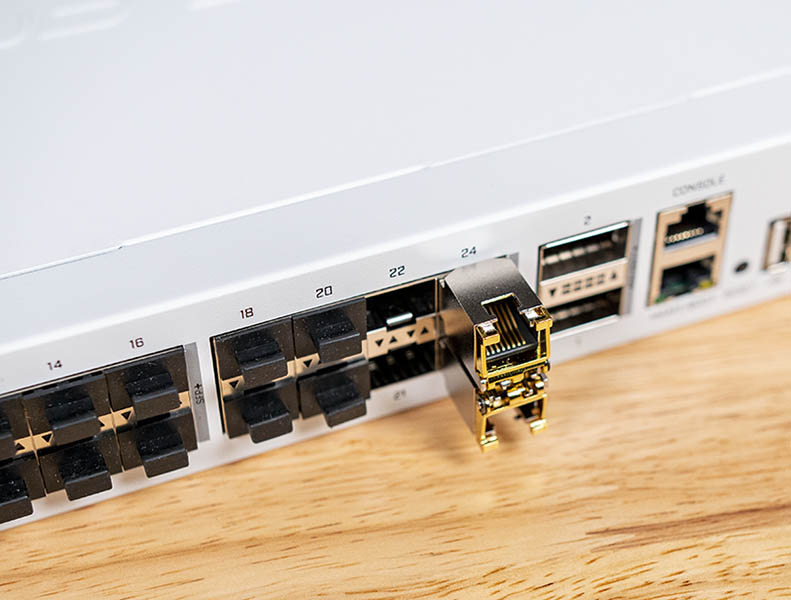
The switch in these photos is actually the CRS326-24S+2Q+RM which is in our review queue, but you could use them with the MikroTik CRS305-1G-4S+IN or CRS317-1G-16S+RM as examples. We even took the WinBox image below with one working in a 2015 era MikroTik CRS226-24G-2S+IN. Given the additional power that these use, and it is significant in MikroTik’s switch products, you need to consult with a reseller and MikroTik’s documentation on how many you can use in a switch and if there are any changes to switch behavior such as fans that will need to turn on if you use them.
Although we have discussed 10Gbase-T here, that is not entirely accurate. Technically, the S+RJ10 supports 10/100, 1GbE, 2.5GbE, and 5GbE speeds as well. This is designed to deliver Nbase-T connectivity. If you have a SFP+ switch like the MikroTik CRS309-1G-8S+IN you can add one of these to attach the one-off 2.5GbE/ 5GbE NAS, AP, or workstation as well.
On that note, there are some caveats to saying this works at 2.5Gbase-T, 5Gbase-T, and 10Gbase-T speeds. That is cable length and cable type. Here is MikroTik’s official table:

10Gbase-T runs are limited to 30m even over Cat7. The 100-200m limitations are worth being aware of if you are running in an office or home as wiring through conduits often goes further than one estimates. If you have a rack or smaller office space, 30m is ok, but remember that each module will use considerably more power with 10Gbase-T speeds, more at the 30m mark.
A Quick Note MikroTik S+RJ10 Rev 1 v. Rev 2.16
These modules went through an important revision in their lifecycle. The Rev 1 modules were a bit rough around the edges. They did not support features you would expect such as jumbo frames. From the MikroTik site on the newer revision improvements:
- Jumbo frames up to 10218 Bytes are now supported;
- Link speed reporting is fixed – actual link speed in the interface menu is listed. Previously 100M/1G/2.5G/5G link speeds were not reported correctly;
- DDM monitoring (Supply Voltage, Module temperature) is now supported. (Source: MikroTik)
One item we did not like is that the exterior of the modules does not say Rev 2.16 clearly. Instead, you are likely going to need to check with your reseller or plug them into a switch. Here you can see “Vendor Revision 2.16” via WinBox and one of the modules:
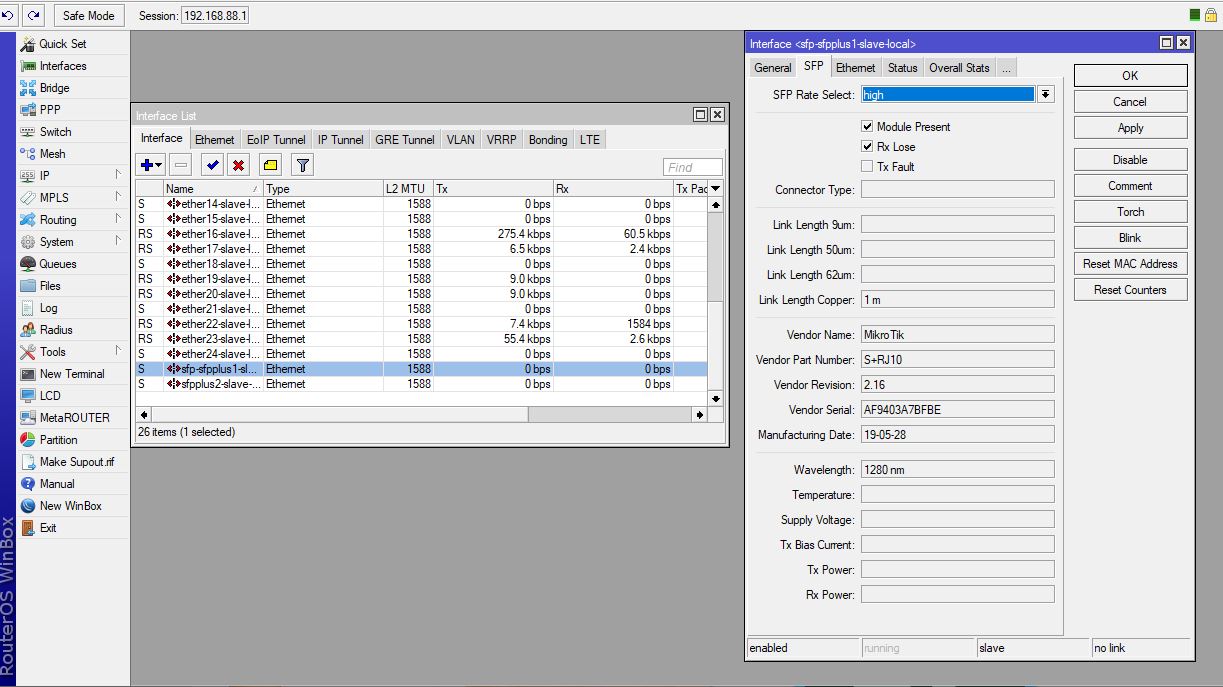
If you are reading this review, it is likely any new S+RJ10 module you will buy is Rev 2.16 or newer. They have been in production for several quarters now. There was a lot of early feedback out there about not having features like jumbo frame support. The Rev 2.16 modules also seem to be more stable from a low quantity observation. If you do see one in the field and are seeing issues, one item on your checklist should be to see if it is a Rev 1.0 module. We would not recommend the Rev 2.16 modules for the heart of switching at the New York Stock Exchange, but if you have an office or even a home setup where you need to connect base-T devices, Rev 2.16 is what you want.
MikroTik S+RJ10 Performance
We ran a few NAS tests to a SFP+ SSD NAS from a workstation with a 2.5/5/10Gbase-T adapter as well as a SFP+ adapter to see the impact of the S+RJ10 running in a MikroTik CRS309-1G-8S+IN switch.
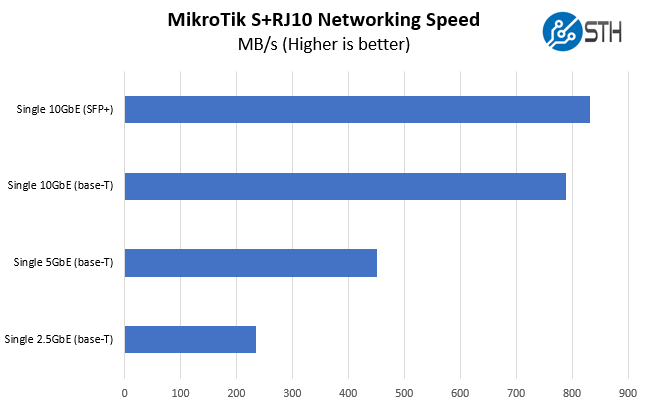
We lost a bit by moving to 10Gbase-T on our test setup, but we saw generally good results in what we think will be a common use case. If you have a SFP+ switch and a 2.5GbE or 5GbE NAS, the S+RJ10 gives you a lot more performance at only $55 or so to connect the NAS.
Final Words
The MikroTik S+RJ10 we look at as a tool. Putting 8, 16, or 24 of these into a SFP+ switch is not the best use of resources. The MikroTik CRS312-4C+8XG-RM has 12x 10Gbase-T ports at $500 or under $42/ port. Converting a SFP+ port using the S+RJ10 is around $55 plus the switch port. At the same time, if you have an existing switch and need a small number of 2.5/5/10Gbase-T ports, such as 1-3, it can be easier to use the S+RJ10 over adding another switch. This is a case of being a good value in small quantities, but not necessarily large ones.

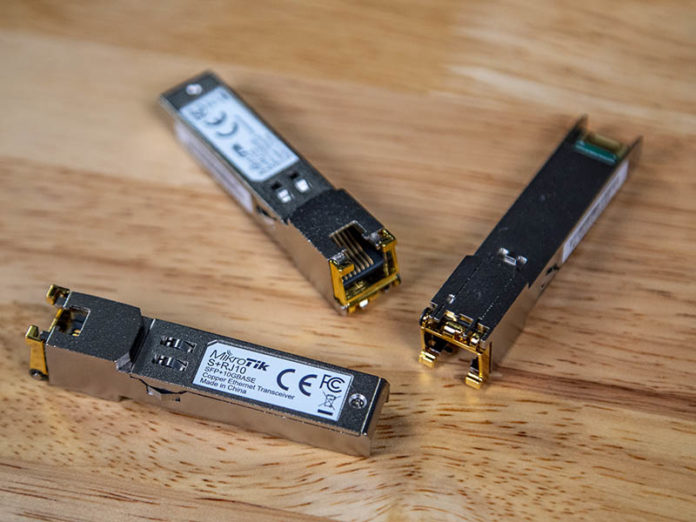



It’s worth noting for anyone new to SFP+ ports, typically anything you plug in transceivers or DACs needs to be compatible with the vendor of the device with the SFP+ ports.
Why anyone would pay that much just to convert SFP+ to RJ-45 rather than just buying a different NIC or switch – to replace RJ-45 ports – is beyond me. It would certainly make more sense.
@Cyryl it would certainly make sense …. if you have money growing on your back.
@Cyryl. Many computers (and NASes) that have 10GbE integrated don’t have PCIe slots to simply add a cheap SFP+ NIC.
Mac mini and iMac Pro comes to mind. There this solution would be much cheaper than buying an SFP+ Thunderbolt adaptor such as the $200 QNAP T310GS1.
Or if you get a cheapo 2.5G or 5G NAS and have a SFP+ network $60 is way cheaper to do this.
You spend $55 on the S+RJ10 but save $15 on the DAC and more if you need optics for 10m
It all depends on the 10Gb port mix you need compared to what’s available from the switch vendor. If your network is mostly DAC and/or fibre with only a few 10GBaseT, using RJ45 transceivers in a SFP+ switch is a valid option.
It’s helpful to know that Mikrotik has improved this product.
I saw the bad comments about rev1 and never looked for a rev2.
@cyryl if you have a 16 port sfp+ switch and need 1 or 2 10baseT ports, this is easy and worth a few bucks. @Stanley standard I never thought of it that way but you’ve got a point
Nice to see them add Nbase-T support. As others have mentioned it depends on port densities….if I have a switch with 30+ optical SFP+ modules and need 10G Base-T for just 2-3 ports it makes sense. The bigger issue with SPF+ modules is the coding, rather the switch vendor SPF+ module coding restrictions.
Does anyone know if the eeprom space on these are re-programmable?
Have you heard of Cat6A? Been around a while.
10G-T at 100m.
I’m looking forward to reading the CRS326-24S+2Q+RM in-depth review, when can I expect it to be published, STH?
@Toby Standard 10GBASE-T can reach 100m with Cat6A or 55m with Cat6. Due to power constraints, SFP+ RJ45 transceivers typically limit 10Gb links to 30m, regardless of cabling.
I probably got the first revisions.. cause it kind of matches “We originally bought several of the MikroTik S+RJ10 modules when they first came out, and were, well disappointed.”
I to am disappointing.. 1 stopped working reasonably quickly. Gave up on 10Gb.. but if rev 2+ seem to resolve, i might by a pair and test..
Can anyone recommend a vendor that has version 2.16 that is not Amazon? I stumbled on to this article by chance, and I am glad to learn why I could never get Jumbo frames enabled, and that some of the weird behavior wasnt necessarily my doing. Sure enough my Amazon purchased transceivers are 1.0. They’re going back, but I need to find someone else in the states that sells these.
There is also a revision 3 of the S+RJ0 module to fix the link speed reported issue.
I have contacted the Mikrotik support for a replacement of the Rev 1 module because they still selling these items without any hint. I never get a response.
Ordered 1 of these from Amazon this week. The Revision 2.16 arrived today. Packaging was not good. A plastic ziplock in an unpadded envelope. This was from Amazon, not a reseller. It was recognized in Winbox though.
I am using this module with a 5GBase-T connection. When I use iperf3 to messure the throughput, data send to the 5Gbase-T adapter uses 5Gbps, while data received from it is capped at 1Gbps. Is this a restriction of the modul?
I tried the 5Gbit adapter (QNAP QNA-UC5G1T) with esxi and windows – the result is the same in both cases, so it less likely a driver problem.
It would have been helpful, if the review would have covered the send and receive throughput individualy.
MikroTik says that these should not be used side by side due to heat – that they should be used in every other port. So likely a good solution for a one or two off for home or specialized setup but you can’t put 8 of these in a a row and expect things to stay cool.
I have one of these, using it with my CRS-317.
I’m struggling with getting a proper connection over a 2.5Gbps uplink to my 1Gbps WAN/firewall. Download speeds are fine (1 Gbps), but upload speeds are consistently approximately halved (400-600 Mbps).
I’ve confirmed it’s the 2.16 revision, and it says it’s got 2.5 Gbps full duplex within Mikrotik’s WebFig, but I don’t believe it.
I’m ordering their 1Gbps SFP+ to RJ-45 module to compare.